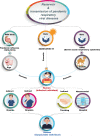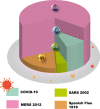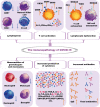Narrative review on century of respiratory pandemics from Spanish flu to COVID-19 and impact of nanotechnology on COVID-19 diagnosis and immune system boosting
- PMID: 36280866
- PMCID: PMC9589879
- DOI: 10.1186/s12985-022-01902-2
Narrative review on century of respiratory pandemics from Spanish flu to COVID-19 and impact of nanotechnology on COVID-19 diagnosis and immune system boosting
Abstract
The rise of the highly lethal severe acute respiratory syndrome-2 (SARS-2) as corona virus 2019 (COVID-19) reminded us of the history of other pandemics that happened in the last century (Spanish flu) and stayed in the current century, which include Severe-Acute-Respiratory-Syndrome (SARS), Middle-East-Respiratory-Syndrome (MERS), Corona Virus 2019 (COVID-19). We review in this report the newest findings and data on the origin of pandemic respiratory viral diseases, reservoirs, and transmission modes. We analyzed viral adaption needed for host switch and determinants of pathogenicity, causative factors of pandemic viruses, and symptoms and clinical manifestations. After that, we concluded the host factors associated with pandemics morbidity and mortality (immune responses and immunopathology, ages, and effect of pandemics on pregnancy). Additionally, we focused on the burdens of COVID-19, non-pharmaceutical interventions (quarantine, mass gatherings, facemasks, and hygiene), and medical interventions (antiviral therapies and vaccines). Finally, we investigated the nanotechnology between COVID-19 analysis and immune system boosting (Nanoparticles (NPs), antimicrobial NPs as antivirals and immune cytokines). This review presents insights about using nanomaterials to treat COVID-19, improve the bioavailability of the abused drugs, diminish their toxicity, and improve their performance.
Keywords: Immune system; Nanotechnology; Respiratory pandemics; SARS-CoV-2; Spanish flu.
© 2022. The Author(s).
Conflict of interest statement
No conflict of interests.
Figures










Similar articles
-
A Game of Infection - Song of Respiratory Viruses and Interferons.Front Cell Infect Microbiol. 2022 Jun 29;12:937460. doi: 10.3389/fcimb.2022.937460. eCollection 2022. Front Cell Infect Microbiol. 2022. PMID: 35846766 Free PMC article. Review.
-
Overview of Immune Response During SARS-CoV-2 Infection: Lessons From the Past.Front Immunol. 2020 Aug 7;11:1949. doi: 10.3389/fimmu.2020.01949. eCollection 2020. Front Immunol. 2020. PMID: 32849654 Free PMC article. Review.
-
Fighting the War Against COVID-19 via Cell-Based Regenerative Medicine: Lessons Learned from 1918 Spanish Flu and Other Previous Pandemics.Stem Cell Rev Rep. 2021 Feb;17(1):9-32. doi: 10.1007/s12015-020-10026-5. Stem Cell Rev Rep. 2021. PMID: 32789802 Free PMC article. Review.
-
Nanobiosensors for the Detection of Novel Coronavirus 2019-nCoV and Other Pandemic/Epidemic Respiratory Viruses: A Review.Sensors (Basel). 2020 Nov 18;20(22):6591. doi: 10.3390/s20226591. Sensors (Basel). 2020. PMID: 33218097 Free PMC article. Review.
-
Biological, clinical and epidemiological features of COVID-19, SARS and MERS and AutoDock simulation of ACE2.Infect Dis Poverty. 2020 Jul 20;9(1):99. doi: 10.1186/s40249-020-00691-6. Infect Dis Poverty. 2020. PMID: 32690096 Free PMC article. Review.
Cited by
-
Severity of COVID-19 in Patients with Diarrhoea: A Systematic Review and Meta-Analysis.Trop Med Infect Dis. 2023 Jan 26;8(2):84. doi: 10.3390/tropicalmed8020084. Trop Med Infect Dis. 2023. PMID: 36828500 Free PMC article. Review.
-
Role of tomography in the screening at the emergency room during pandemics.Clinics (Sao Paulo). 2024 Dec 12;80:100559. doi: 10.1016/j.clinsp.2024.100559. eCollection 2025. Clinics (Sao Paulo). 2024. PMID: 39671880 Free PMC article. No abstract available.
-
25 Years Responding to Respiratory and Other Viruses with Mass Spectrometry.Mass Spectrom (Tokyo). 2023;12(1):A0136. doi: 10.5702/massspectrometry.A0136. Epub 2023 Dec 1. Mass Spectrom (Tokyo). 2023. PMID: 38053835 Free PMC article. Review.
References
Publication types
MeSH terms
Substances
LinkOut - more resources
Full Text Sources
Medical
Miscellaneous

